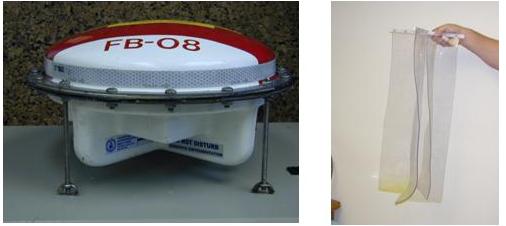In response to NOAA/COP funded research needs for high resolution Lagrangian analysis of Florida Bay interior basin flow fields,
a shallow water drift buoy was designed and developed by AOML and RSMAS in Miami, Florida.
Primary design guidelines required a device capable of operating in water depths of one meter or less for up to a two week period. Small size was a factor both in minimizing windage at the surface and in aiding deployment and recovery efforts. The drifter would also require onboard GPS for accurate positioning. The need for a high-resolution record of the drifter track required GPS data to be logged onboard for post-recovery upload. However, in attempts to aid users in the drifter's recovery, a subset of these data would need to be transmitted to the users during deployment; this is handled by an onboard ARGOS transmitter.
The hull is constructed of a 0.125 inch thick lexan, two-piece thermoformed shell in the general shape of a disc. The top is slightly domed and the bottom has molded fins in an attempt to couple the buoy to the water. Unfortunately, in the first Bay drift test the molded fins proved to be insufficient to keep windage to a minimum, so a "window shade" drogue has been incorporated with excellent results to improve coupling to the water (see Figure).
The drogue is constructed of two crossed, flexible PVC sheets and is approximately 0.75 meters long. The shape of the buoy was analyzed to insure that it would be self-righting if turned over by a wave. When deployed, the hull floats with the top of the dome approximately 3 cm above the waterline. The dimensions of the hull are 33 cm in diameter by 15 cm high and the weight ready for deployment is less than 5 kg.
To derive high-resolution currents, the position of the buoy must be determined frequently. A Motorola 12 channel GPS receiver is built into the electronics to collect this data. It computes 3 dimensional position information at pre-selected rates which are then stored in the buoy memory for later retrieval and subsequent data analysis. A relocation ARGOS satellite transmitter system is included in the electronics to recover the buoy at the end of each experiment. The ARGOS positions are used to get within the general vicinity of the buoy, and then a handheld ARGOS receiver on the boat is used to locate and retrieve the buoy.
